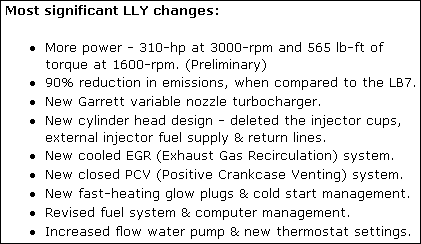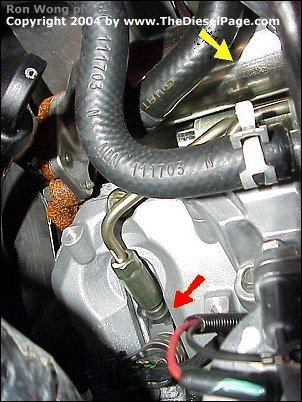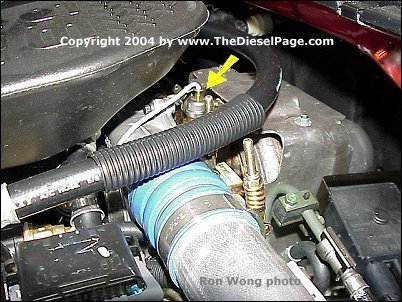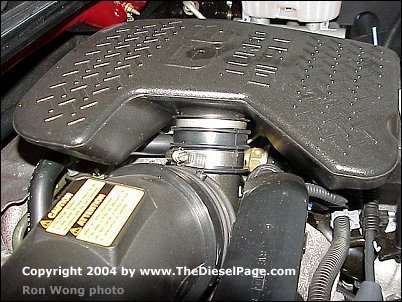|
 LLY Duramax 6600 Technology changes for 2004 By Jim Bigley Photos by Ron Wong The 2001 through mid model-year 2004 Duramax 6600 diesel engine was designated RPO (Regular Production Option) code LB7. The LB7 was introduced in the fall of 2000 with an industry leading 300 horsepower and 520 lb-ft torque rating. Not only was it the most powerful engine in this market segment, but it was also a revolutionary step forward in light-truck diesel engine technology and was the first competitive diesel engine designed in recent times for the current light-truck market. Numerous new technologies were engineered into the LB7 design, creating an engine package that met both emissions requirements and consumer performance expectations. Enter the LLY... Introduced in January of 2004, the RPO code LLY Duramax 6600 incorporates a number of significant technology changes. Two forces control diesel engine evolution for all engine manufacturers - Emissions compliance and market share. The technology changes introduced with the LLY address both of these forces. Creating an engine with more power and lower emissions has become more challenging, but that's exactly what the LLY delivers. 
Way back in the fall of 2001, rumors and discussion with industry insiders pointed to a 340 horsepower Duramax 6600 for the 2004 model year. As late as a year ago, a 360 horsepower Duramax came up in a discussion. GM has been playing with Duramax power levels, but what actually makes it into production is another matter. The Duramax is more than capable, and the aftermarket has shown us what just a few power enhancements can do to create tire smoking - neck snapping performance.
The LLY's 310/565 power level was published (for internal use) sometime mid-2003. Since then, both GM & Ford have jockeyed for position, and we have since learned that the regular production power/torque specs for the LLY will be somewhat higher. A torque number of 590 lb-ft for the LLY has been stated in recent television commercials produced by Chevrolet and 590 has shown up in a variety of publications, such as the March/April 2004 issue of Truck Trend magazine. Reports have indicated that the horsepower and torque increase will only be available in 2nd, 3rd and 4th gears (Allison automatic), and the LLY's power/torque will remain at the previous LB7 level of 300/520 in 1st and 5th. Meeting the HDE (heavy-duty emissions) regulations is more than a little troublesome. SAE paper 2000-01-3513 discusses the LB7 Duramax fuel injection system and how it was optimized for emissions control. The last couple of pages discuss the 2007 emissions regulations and what challenges are facing all diesel engine manufacturers. Meeting the proposed 2007 emissions limits (specifically particulates - PM & oxides of Nitrogen - NOx) means reducing the current 2004 emissions by a factor of ten (current 0.1 g/bhp-hr particulates to 0.01 g/bhp-hr). As an aside, the LLY is said to reduce both NOx and hydrocarbons by 90%, when compared to the LB7 - a remarkable feat. The atmosphere contains approximately 78% Nitrogen and 20.9% Oxygen. When these gases are subjected to high combustion temperatures (1370°C or above) inside an internal combustion engine, they react to form oxides of Nitrogen - a significant component in smog. Reducing combustion temperatures reduce NOx, and one common method used to reduce combustion temperatures is to employ the use of EGR (Exhaust Gas Recirculation). Recycled exhaust gases contain less Oxygen, which lower combustion temperatures when combined with an engine's intake air. PM (particulates) - in the form of soot - is also a concern. The primary method employed to reduce soot is to first design an efficient intake/turbo system that provides an excess of air (lean stoichiometric ratio). This, combined with a high-pressure common rail fuel injection system and optimized piston/valve design also contribute to a clean burn. Another common PM reduction strategy is to employ exhaust aftertreatment (i.e. catalytic converter). The California LB7 and all LLY engines are equipped with catalytic converters, designed to trap and vaporize PM (soot) expelled by the engine. The LLY got a new catalytic converter design for 2004 that is the same size as those used on the LB7, but the quantities of precious metals and resulting effectiveness have increased. I was encouraged to learn last year that GM had been running 2007 emissions qualified prototype Duramax 6600 diesels for quite some time. However, to meet the stringent emissions limits, their engineering team was forced to import diesel fuel from Sweden - the world leader in clean diesel fuel. Assuming the US refineries can produce diesel fuel comparable to Sweden's by 2007, diesel power could be with us for quite a while. However, look for more exotic exhaust aftertreatment and EGR technology in the coming years. 
Cooled EGR: EGR flow is controlled by the LLY's brand new E60 ECM and digitally controlled EGR valve, with programming that takes into account the heat load imposed on the engine's cooling system by the hot exhaust gases. EGR flow can occur when IAT (intake air temperature) is above 41.5°F and with an engine temperature between approximately 140°F and 211°F. Terminating EGR flow above 211°F helps to preserve the cooling ability of the engine. The EGR stepper motor and control valve assembly are serviceable, and new OBD II diagnostic procedures allow the technician to monitor/test the operation of the EGR. EGR flow is disabled if any of the EGR related DTC's are set. 
The arrow near the top of the image on the left points to the stainless steel cylinder that is part of the cooled EGR system. Engine coolant is used to cool EGR flow. Exhaust gases are scavenged from the right side turbo exhaust inlet pipe, cooled by coolant flow, then injected into the intake manifold on the engine. The combination of exhaust restriction produced by the turbo, catalytic converter and exhaust system raise the exhaust backpressure to a level above intake manifold pressure. For now at least, EGR flow is not being routed through the intercooler. The lower arrow points to one portion of the new scalloped valve covers used on the LLY. The longer-redesigned injectors move all fuel supply and return lines to outside the engine. The potential for a fuel/oil dilution problem has been reduced significantly. LLY fuel injectors, fuel injection pump, and cylinder heads are not interchangeable with those produced for an LB7. While the critics expected the aluminum cylinder heads to be the Achilles heel of the Duramax, 3-½ model years and hundreds of thousands of trucks have proven the viability and durability of aluminum. In fact, aluminum cylinder heads are key to the success of the Duramax. Aluminum is here to stay. In addition to the re-design to accommodate external fuel injectors, the intake ports in the cylinder heads were repositioned relative to the combustion chamber, to increase swirl and enhance the mixing effect of the air/EGR/fuel. Lower emissions and improved combustion efficiency result from these changes. And finally, the stainless steel injector cups utilized by the LB7 have been eliminated in the LLY. Now, the fuel injectors pass through and mount directly to the cylinder head, and are serviceable/replaceable without removing the valve covers. Eliminating the injector cups removes a potential for cup coolant/compression leaks. External fuel supply/return lines and elimination of the injector cups improve reliability and serviceability. Garrett Variable Nozzle Turbocharger: One important turbocharger performance parameter is its efficiency at converting energy to boost pressure. Heat and pressure drop across the turbine is the energy that spins the turbine and compressor wheel of the turbocharger. An efficient turbo spins up fast to produce boost pressure early, but does not create excessive exhaust backpressure at the engine's upper operating range. A fixed turbine, like that used on the LB7, was designed to produce efficient operation over a specific engine operating range, and a certain amount of compromise had to be accepted to get the desired boost pressure and flow rates. In general, these compromises can result in too little boost at low engine RPM & power levels and/or excessive exhaust backpressure at high engine RPM & power levels. A variable nozzle turbocharger addresses these deficiencies, allowing for a quicker-acting turbocharger at low power levels, yet can significantly reduce turbine-induced exhaust backpressure at high power and RPM levels. It has been reported that this new Garrett variable nozzle turbocharger is largely responsible for most of the power gain available in the LLY (now and in the future). As a point of interest, we know that the LB7's turbocharger employed a water-cooled center section, and we know that the new Garrett variable nozzle turbo does not. Most of us thought a water-cooled turbo would improve durability, but SAE paper 2001-01-2703 indicates that coolant flow through the LB7's turbo was thermostatically controlled, with flow stopping once the engine reached operating temperature - designed primarily to quicken engine warm-up. 
The arrow in this image points to the new turbo vane position sensor. A Vane Position Control Solenoid valve (located on right side of turbo center-section) uses engine oil pressure and computer controlled valving to move the turbo's variable vane mechanism. The analog sensor reads the vane position, then an inline 10-bit A/D signal converter converts the analog signal to a digital component that is read by the ECM. Both the sensor and the control valve are easily serviced/replaced, and new OBD II diagnostic procedures allow the technician to monitor the operation of these components.

The variable portion of the Garrett turbocharger incorporates nine airfoil shaped vanes operating on a slotted ring. The computer controlled hydraulic actuating servo rotates the ring to change each vane position in unison, which varies the velocity of the exhaust gases acting on the turbine wheel. This computer-controlled variable action provides real-time control over boost pressure, eliminating the need for a wastegate. A new set of diagnostic troublecodes are available to help troubleshoot a variable nozzle turbo or boost pressure related fault. 
Fast heating glow plugs: The glow system has been modified to improve cold starting and reduce white smoke when cold. The LLY's glow system "Wait to Start" lamp will illuminate now for just three seconds. The new silver tipped glow plugs (LB7's were gold) are designed to reach 1000°C (1832°F) in just 1.8 seconds, and then PWM (pulse width modulation) is used to maintain that temperature for the remainder of the three seconds. In addition, each new fuel injector has one of its seven spray holes oriented to spray directly onto the heated glow plug tip. Total glow system current draw peaks at 110 amps for the 1.8 second initial heat cycle, then the current is reduced to 30 amps for the remaining 1.2 seconds to maintain the 1000° temperature. Also new is the individual glow plug control, where the LB7's glow plugs were ganged on a common circuit. This allows glow control for individual cylinders and improved glow plug diagnostic ability using a set of eight new trouble codes. 
In addition to the above changes incorporated into the LLY, the engine also includes a new closed PCV (Positive Crankcase Venting) system, the fuel-rail pressure sensor is now capable of measuring up to 200 MPa (up from 180), and there is a new test kit and procedure that streamlines the fuel injector flow-rate tests. The new PCV system now routes crankcase gases into the turbo air inlet, to be recycled in the combustion process. An oil film is considered normal inside the turbo compressor and intercooler/ducting/intake manifold due to the composition of the crankcase gases. The LLY also includes a new engine cover, which doubles as a "dead space chamber", designed to reduce intake noise during part throttle operation. Emissions compliance and competition for market share have made all brands of diesel engines more complex, while at the same time lowering emissions and improving performance. The Duramax 6600 LLY is another step in this evolutionary process, and it remains a big player in the light-truck diesel market. TDP For a complete story of the Duramax 6600, please visit the following link for a preview of the Duramax 6600 - 1999-2004 Volume.. What's New: | Feature Articles: | Product Reviews: | Member's Area: Join Us: | Duramax Diesel Page: | Advertisers: | Classified Ads: | Books:
Send e-mail to: turbo@TheDieselPage.com |